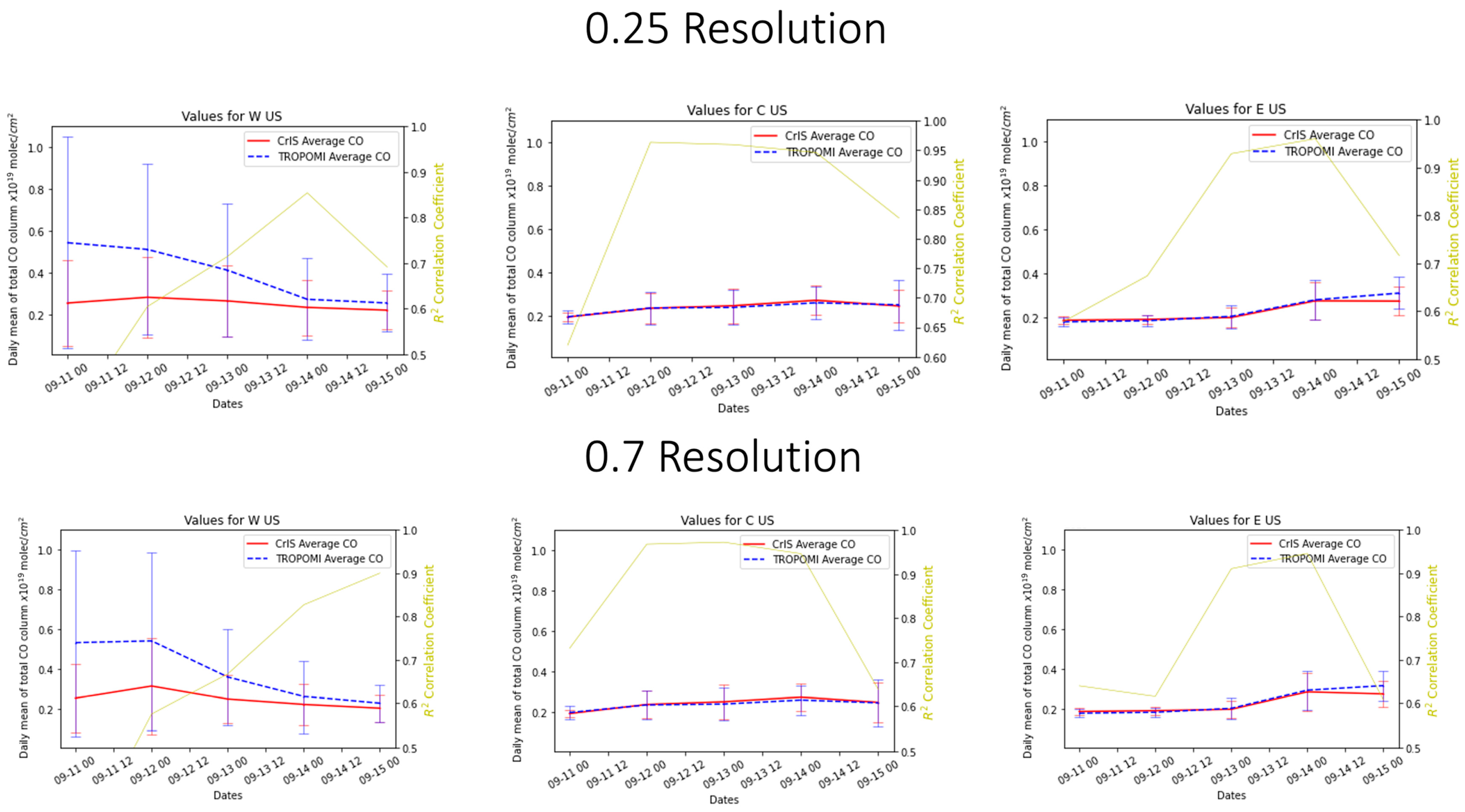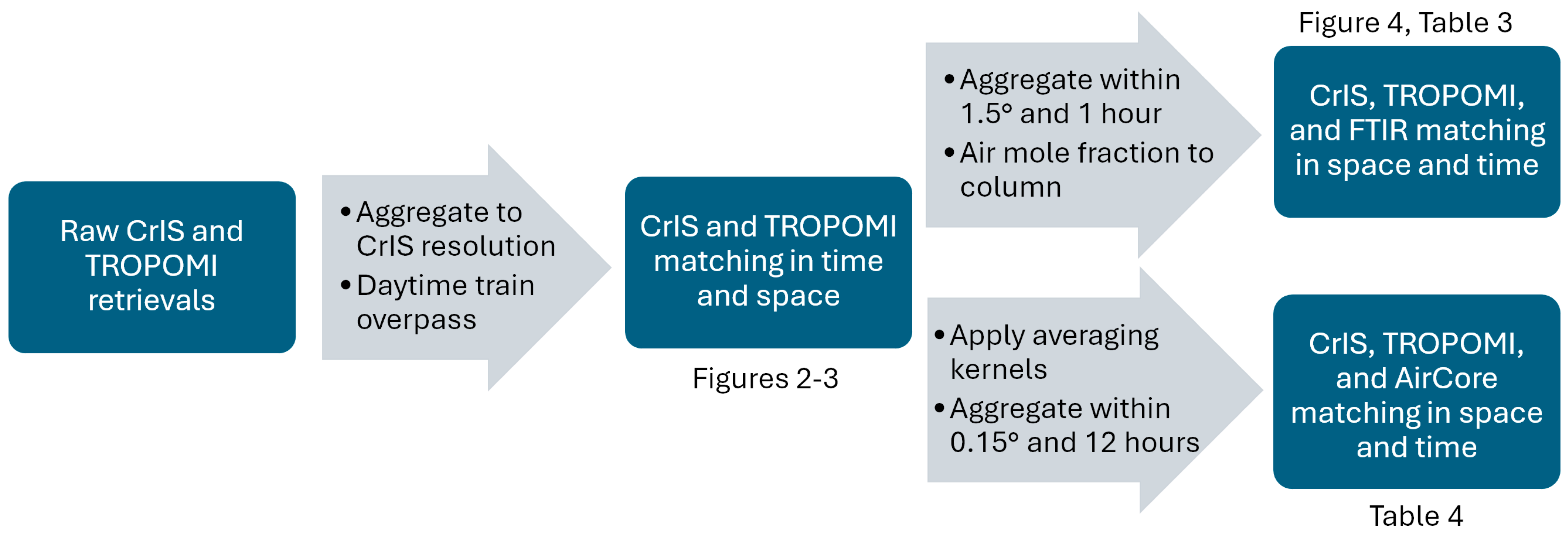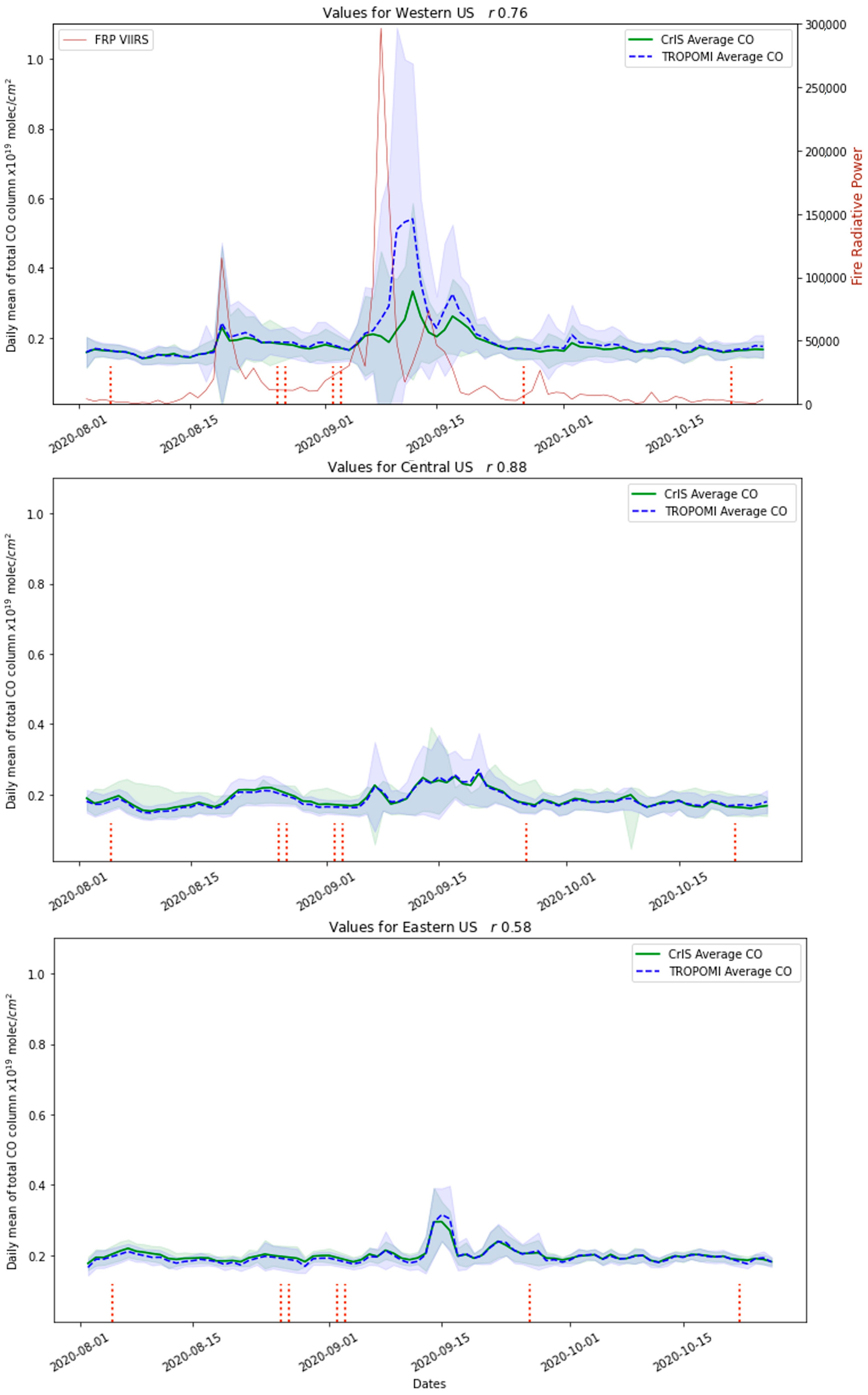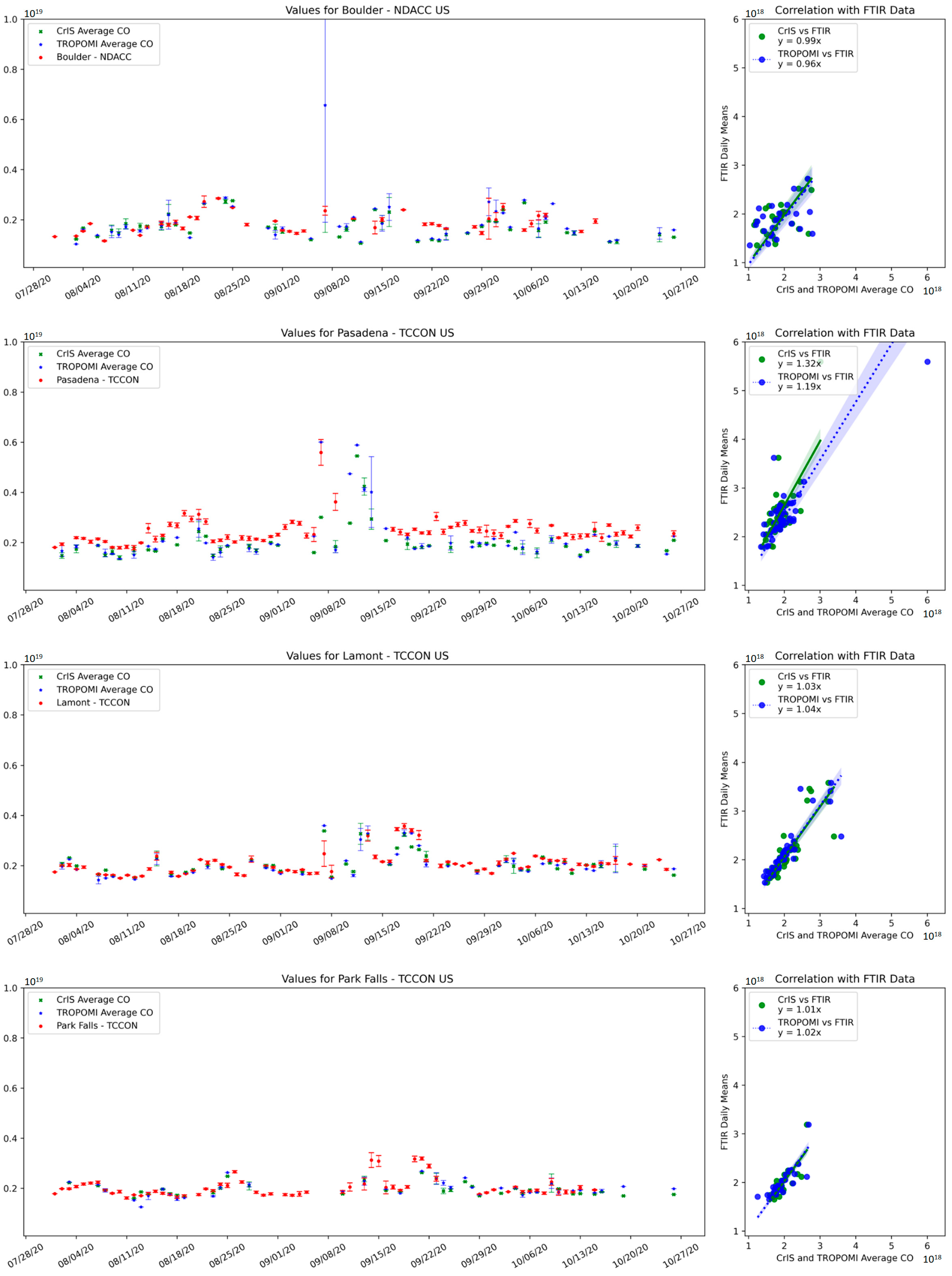An Assessment of TROPESS CrIS and TROPOMI CO Retrievals and Their Synergies for the 2020 Western U.S. Wildfires
Abstract
1. Introduction
2. Data and Methods
2.1. Satellite CO Retrievals
2.1.1. CrIS CO
2.1.2. TROPOMI CO
2.2. Reference Data
2.2.1. Satellite Fire Radiative Power Retrievals from VIIRS
2.2.2. Ground-Based TCCON CO Measurements
2.2.3. Ground-Based NDACC-IRWG CO Retrievals
2.2.4. CO Vertical Profiles from AirCore
2.3. Collocation of Datasets
2.3.1. Temporal Colocation of Satellites
2.3.2. Re-Gridding of Satellite Data
2.4. FTIR Colocation
2.5. Collocation to AirCore Data
3. Results and Discussion
3.1. Satellite Synergy Evaluation
3.2. Evaluation Using Ground-Based and AirCore Data
3.2.1. FTIR/Satellite
3.2.2. AirCore/Satellite
4. Conclusions and Future Directions
Author Contributions
Funding
Data Availability Statement
Conflicts of Interest
Appendix A

References
- Albores, I.S.; Buchholz, R.R.; Ortega, I.; Emmons, L.K.; Hannigan, J.W.; Lacey, F.; Pfister, G.; Tang, W.; Worden, H.M. Continental-scale Atmospheric Impacts of the 2020 Western U.S. Wildfires. Atmos. Environ. 2023, 294, 119436. [Google Scholar] [CrossRef]
- Li, Y.; Tong, D.; Ma, S.; Zhang, X.; Kondragunta, S.; Li, F.; Saylor, R. Dominance of Wildfires Impact on Air Quality Exceedances During the 2020 Record-Breaking Wildfire Season in the United States. Geophys. Res. Lett. 2021, 48, e2021GL094908. [Google Scholar] [CrossRef]
- Higuera, P.E.; Abatzoglou, J.T. Record-setting climate enabled the extraordinary 2020 fire season in the western United States. Glob. Change Biol. 2021, 27, 1–2. [Google Scholar] [CrossRef] [PubMed]
- Ye, X.; Deshler, M.; Lyapustin, A.; Wang, Y.; Kondragunta, S.; Saide, P. Assessment of Satellite AOD during the 2020 Wildfire Season in the Western U.S. Remote Sens. 2022, 14, 6113. [Google Scholar] [CrossRef]
- Martínez-Alonso, S.; Deeter, M.; Worden, H.; Borsdorff, T.; Aben, I.; Commane, R.; Daube, B.; Francis, G.; George, M.; Landgraf, J.; et al. 1.5 years of TROPOMI CO measurements: Comparisons to MOPITT and ATom. Atmos. Meas. Tech. 2020, 13, 4841–4864. [Google Scholar] [CrossRef]
- Timofeev, Y.M.; Nerobelov, G.M. Satellite Investigations of the Atmospheric Gas Composition. Izv. Atmos. Ocean. Phys. 2024, 60, 660–688. [Google Scholar] [CrossRef]
- Laughner, J.L.; Neu, J.L.; Schimel, D.; Wennberg, P.O.; Barsanti, K.; Bowman, K.W.; Chatterjee, A.; Croes, B.E.; Fitzmaurice, H.L.; Henze, D.K.; et al. Societal shifts due to COVID-19 reveal large-scale complexities and feedbacks between atmospheric chemistry and climate change. Proc. Natl. Acad. Sci. USA 2021, 118, e2109481118. [Google Scholar] [CrossRef]
- Clerbaux, C.; Boynard, A.; Clarisse, L.; George, M.; Hadji-Lazaro, J.; Herbin, H.; Hurtmans, D.; Pommier, M.; Razavi, A.; Turquety, S.; et al. Monitoring of atmospheric composition using the thermal infrared IASI/MetOp sounder. Atmos. Chem. Phys. 2009, 9, 6041–6054. [Google Scholar] [CrossRef]
- Bowman, K.W.; Rodgers, C.D.; Kulawik, S.S.; Worden, J.; Sarkissian, E.; Osterman, G.; Steck, T.; Ming, L.; Eldering, A.; Shephard, M.; et al. Tropospheric emission spectrometer: Retrieval method and error analysis. IEEE Trans. Geosci. Remote Sens. 2006, 44, 1297–1307. [Google Scholar] [CrossRef]
- Bloom, H.J. The Cross-track Infrared Sounder (CrIS): A sensor for operational meteorological remote sensing. In Proceedings of the IGARSS 2001. Scanning the Present and Resolving the Future. Proceedings. IEEE 2001 International Geoscience and Remote Sensing Symposium (Cat. No.01CH37217), Sydney, NSW, Australia, 9–13 July 2001; Volume1343, pp. 1341–1343. [Google Scholar]
- Worden, H.M.; Francis, G.L.; Kulawik, S.S.; Bowman, K.W.; Cady-Pereira, K.; Fu, D.; Hegarty, J.D.; Kantchev, V.; Luo, M.; Payne, V.H.; et al. TROPESS/CrIS carbon monoxide profile validation with NOAA GML and ATom in situ aircraft observations. Atmos. Meas. Tech. 2022, 15, 5383–5398. [Google Scholar] [CrossRef]
- Fu, D.; Kulawik, S.S.; Miyazaki, K.; Bowman, K.W.; Worden, J.R.; Eldering, A.; Livesey, N.J.; Teixeira, J.; Irion, F.W.; Herman, R.L.; et al. Retrievals of tropospheric ozone profiles from the synergism of AIRS and OMI: Methodology and validation. Atmos. Meas. Tech. 2018, 11, 5587–5605. [Google Scholar] [CrossRef]
- Buchholz, R.R.; Deeter, M.N.; Worden, H.M.; Gille, J.; Edwards, D.P.; Hannigan, J.W.; Jones, N.B.; Paton-Walsh, C.; Griffith, D.W.T.; Smale, D.; et al. Validation of MOPITT carbon monoxide using ground-based Fourier transform infrared spectrometer data from NDACC. Atmos. Meas. Tech. 2017, 10, 1927–1956. [Google Scholar] [CrossRef]
- Bowman, K.W.; Steck, T.; Worden, H.M.; Worden, J.; Clough, S.; Rodgers, C. Capturing time and vertical variability of tropospheric ozone: A study using TES nadir retrievals. J. Geophys. Res. Atmos. 2002, 107, ACH 21-1–ACH 21-11. [Google Scholar] [CrossRef]
- Borsdorff, T.; Aan de Brugh, J.; Hu, H.; Aben, I.; Hasekamp, O.; Landgraf, J. Measuring Carbon Monoxide with TROPOMI: First Results and a Comparison with ECMWF-IFS Analysis Data. Geophys. Res. Lett. 2018, 45, 2826–2832. [Google Scholar] [CrossRef]
- Fu, D.; Bowman, K.W.; Worden, H.M.; Natraj, V.; Worden, J.R.; Yu, S.; Veefkind, P.; Aben, I.; Landgraf, J.; Strow, L.; et al. High-resolution tropospheric carbon monoxide profiles retrieved from CrIS and TROPOMI. Atmos. Meas. Tech. 2016, 9, 2567–2579. [Google Scholar] [CrossRef]
- Worden, H.M.; Deeter, M.N.; Frankenberg, C.; George, M.; Nichitiu, F.; Worden, J.; Aben, I.; Bowman, K.W.; Clerbaux, C.; Coheur, P.F.; et al. Decadal record of satellite carbon monoxide observations. Atmos. Chem. Phys. 2013, 13, 837–850. [Google Scholar] [CrossRef]
- Martínez-Alonso, S.; Deeter, M.N.; Worden, H.M.; Gille, J.C.; Emmons, L.K.; Pan, L.L.; Park, M.; Manney, G.L.; Bernath, P.F.; Boone, C.D.; et al. Comparison of upper tropospheric carbon monoxide from MOPITT, ACE-FTS, and HIPPO-QCLS. J. Geophys. Res. Atmos. 2014, 119, 14,144–14,164. [Google Scholar] [CrossRef]
- George, M.; Clerbaux, C.; Bouarar, I.; Coheur, P.F.; Deeter, M.N.; Edwards, D.P.; Francis, G.; Gille, J.C.; Hadji-Lazaro, J.; Hurtmans, D.; et al. An examination of the long-term CO records from MOPITT and IASI: Comparison of retrieval methodology. Atmos. Meas. Tech. 2015, 8, 4313–4328. [Google Scholar] [CrossRef]
- Martinez-Alonso, S.; Aben, I.; Baier, B.C.; Borsdorff, T.; Deeter, M.N.; McKain, K.; Sweeney, C.; Worden, H. Evaluation of MOPITT and TROPOMI carbon monoxide retrievals using AirCore in situ vertical profiles. Atmos. Meas. Tech. Discuss. 2022, 15, 4751–4765. [Google Scholar] [CrossRef]
- Dammers, E.; Shephard, M.W.; Palm, M.; Cady-Pereira, K.; Capps, S.; Lutsch, E.; Strong, K.; Hannigan, J.W.; Ortega, I.; Toon, G.C.; et al. Validation of the CrIS fast physical NH3 retrieval with ground-based FTIR. Atmos. Meas. Tech. 2017, 10, 2645–2667. [Google Scholar] [CrossRef]
- Hedelius, J.K.; Liu, J.; Oda, T.; Maksyutov, S.; Roehl, C.M.; Iraci, L.T.; Podolske, J.R.; Hillyard, P.W.; Liang, J.; Gurney, K.R.; et al. Southern California megacity CO2, CH4, and CO flux estimates using ground- and space-based remote sensing and a Lagrangian model. Atmos. Chem. Phys. 2018, 18, 16271–16291. [Google Scholar] [CrossRef]
- Sha, M.K.; Langerock, B.; Blavier, J.F.L.; Blumenstock, T.; Borsdorff, T.; Buschmann, M.; Dehn, A.; De Mazière, M.; Deutscher, N.M.; Feist, D.G.; et al. Validation of methane and carbon monoxide from Sentinel-5 Precursor using TCCON and NDACC-IRWG stations. Atmos. Meas. Tech. 2021, 14, 6249–6304. [Google Scholar] [CrossRef]
- Malina, E.; Bowman, K.W.; Kantchev, V.; Kuai, L.; Kurosu, T.P.; Miyazaki, K.; Natraj, V.; Osterman, G.B.; Oyafuso, F.; Thill, M.D. Joint spectral retrievals of ozone with Suomi NPP CrIS augmented by S5P/TROPOMI. Atmos. Meas. Tech. 2024, 17, 5341–5371. [Google Scholar] [CrossRef]
- Mettig, N.; Weber, M.; Rozanov, A.; Burrows, J.P.; Veefkind, P.; Thompson, A.M.; Stauffer, R.M.; Leblanc, T.; Ancellet, G.; Newchurch, M.J.; et al. Combined UV and IR ozone profile retrieval from TROPOMI and CrIS measurements. Atmos. Meas. Tech. 2022, 15, 2955–2978. [Google Scholar] [CrossRef]
- Landgraf, J.; Hasekamp, O.P. Retrieval of tropospheric ozone: The synergistic use of thermal infrared emission and ultraviolet reflectivity measurements from space. J. Geophys. Res. Atmos. 2007, 112. [Google Scholar] [CrossRef]
- Luo, M.; Read, W.; Kulawik, S.; Worden, J.; Livesey, N.; Bowman, K.; Herman, R. Carbon monoxide (CO) vertical profiles derived from joined TES and MLS measurements. J. Geophys. Res. Atmos. 2013, 118, 10,601–10,613. [Google Scholar] [CrossRef]
- Cuesta, J.; Eremenko, M.; Liu, X.; Dufour, G.; Cai, Z.; Höpfner, M.; von Clarmann, T.; Sellitto, P.; Foret, G.; Gaubert, B.; et al. Satellite observation of lowermost tropospheric ozone by multispectral synergism of IASI thermal infrared and GOME-2 ultraviolet measurements over Europe. Atmos. Chem. Phys. 2013, 13, 9675–9693. [Google Scholar] [CrossRef]
- Worden, H.M.; Logan, J.A.; Worden, J.R.; Beer, R.; Bowman, K.; Clough, S.A.; Eldering, A.; Fisher, B.M.; Gunson, M.R.; Herman, R.L.; et al. Comparisons of Tropospheric Emission Spectrometer (TES) ozone profiles to ozonesondes: Methods and initial results. J. Geophys. Res. Atmos. 2007, 112. [Google Scholar] [CrossRef]
- Worden, J.R.; Turner, A.J.; Bloom, A.; Kulawik, S.S.; Liu, J.; Lee, M.; Weidner, R.; Bowman, K.; Frankenberg, C.; Parker, R.; et al. Quantifying lower tropospheric methane concentrations using GOSAT near-IR and TES thermal IR measurements. Atmos. Meas. Tech. 2015, 8, 3433–3445. [Google Scholar] [CrossRef]
- Deeter, M.N.; Martínez-Alonso, S.; Edwards, D.P.; Emmons, L.K.; Gille, J.C.; Worden, H.M.; Sweeney, C.; Pittman, J.V.; Daube, B.C.; Wofsy, S.C. The MOPITT Version 6 product: Algorithm enhancements and validation. Atmos. Meas. Tech. 2014, 7, 3623–3632. [Google Scholar] [CrossRef]
- ESA. Copernicus Sentinel-5P (Processed by ESA), TROPOMI Level 2 Carbon Monoxide Total Column Products. Version 02; European Space Agency: Paris, Frence, 2021. [Google Scholar] [CrossRef]
- Landgraf, J.; aan de Brugh, J.; Scheepmaker, R.; Borsdorff, T.; Hu, H.; Houweling, S.; Butz, A.; Aben, I.; Hasekamp, O. Carbon monoxide total column retrievals from TROPOMI shortwave infrared measurements. Atmos. Meas. Tech. 2016, 9, 4955–4975. [Google Scholar] [CrossRef]
- Csiszar, I.; Wolf, W.; Giglio, L.; Schroeder, W.; Cheng, Z.; NOAA JPSS Program Office. JPSS VIIRS Active Fires (AF) EDR from NDE. 2016. Available online: https://doi.org/10.7289/V5GH9G0T (accessed on 15 May 2025). [CrossRef]
- Wolfe, R.E.; Lin, G.; Nishihama, M.; Tewari, K.P.; Tilton, J.C.; Isaacman, A.R. Suomi NPP VIIRS prelaunch and on-orbit geometric calibration and characterization. J. Geophys. Res. Atmos. 2013, 118, 11,508–11,521. [Google Scholar] [CrossRef]
- Laughner, J.L.; Toon, G.C.; Mendonca, J.; Petri, C.; Roche, S.; Wunch, D.; Blavier, J.-F.; Griffith, D.W.; Heikkinen, P.; Keeling, R.F. The total carbon column observing network's GGG2020 data version. Earth Syst. Sci. Data 2024, 16, 2197–2260. [Google Scholar] [CrossRef]
- Wunch, D.; Toon, G.C.; Blavier, J.-F.L.; Washenfelder, R.A.; Notholt, J.; Connor, B.J.; Griffith, D.W.T.; Sherlock, V.; Wennberg, P.O. The Total Carbon Column Observing Network. Philos. Trans. R. Soc. A Math. Phys. Eng. Sci. 2011, 369, 2087–2112. [Google Scholar] [CrossRef]
- Ortega, I.; Buchholz, R.R.; Hall, E.G.; Hurst, D.F.; Jordan, A.F.; Hannigan, J.W. Tropospheric water vapor profiles obtained with FTIR: Comparison with balloon-borne frost point hygrometers and influence on trace gas retrievals. Atmos. Meas. Tech. 2019, 12, 873–890. [Google Scholar] [CrossRef]
- Wennberg, P.; Roehl, C.; Wunch, D.; Blavier, J.; Toon, G.; Allen, N.; Treffers, R.; Laughner, J. TCCON Data from Caltech (US), Release GGG2020. R0 (Version R0) [Data Set], CaltechDATA. 2022. Available online: https://data.caltech.edu/records/dwedt-mpm96 (accessed on 15 May 2025).
- Hannigan, J.W.; Coffey, M.T.; Goldman, A. Semiautonomous FTS Observation System for Remote Sensing of Stratospheric and Tropospheric Gases. J. Atmos. Ocean. Technol. 2009, 26, 1814–1828. [Google Scholar] [CrossRef]
- Rinsland, C.P.; Goldman, A.; Hannigan, J.W.; Wood, S.W.; Chiou, L.S.; Mahieu, E. Long-term trends of tropospheric carbon monoxide and hydrogen cyanide from analysis of high resolution infrared solar spectra. J. Quant. Spectrosc. Radiat. Transf. 2007, 104, 40–51. [Google Scholar] [CrossRef]
- Olsen, K.S.; Strong, K.; Walker, K.A.; Boone, C.D.; Raspollini, P.; Plieninger, J.; Bader, W.; Conway, S.; Grutter, M.; Hannigan, J.W.; et al. Comparison of the GOSAT TANSO-FTS TIR CH volume mixing ratio vertical profiles with those measured by ACE-FTS, ESA MIPAS, IMK-IAA MIPAS, and 16 NDACC stations. Atmos. Meas. Tech. 2017, 10, 3697–3718. [Google Scholar] [CrossRef]
- Hochstaffl, P.; Schreier, F.; Lichtenberg, G.; Garcia, S.G. Validation of Carbon Monoxide Total Columns from SCIAMACHY with NDACC/TCCON Ground-Based Measurements. Remote Sens. 2018, 10, 223. [Google Scholar] [CrossRef]
- Borsdorff, T.; García Reynoso, A.; Maldonado, G.; Mar-Morales, B.; Stremme, W.; Grutter, M.; Landgraf, J. Monitoring CO emissions of the metropolis Mexico City using TROPOMI CO observations. Atmos. Chem. Phys. 2020, 20, 15761–15774. [Google Scholar] [CrossRef]
- Karion, A.; Sweeney, C.; Tans, P.; Newberger, T. AirCore: An Innovative Atmospheric Sampling System. J. Atmos. Ocean. Technol. 2010, 27, 1839–1853. [Google Scholar] [CrossRef]
- Baier, B.; Sweeney, C.; Tans, P.; Newberger, T.; Higgs, J.; Wolter, S. NOAA AirCore Atmospheric Sampling System Profiles (Version 20210813), NOAA Global Monitoring Laboratory [Data Set]. 2021. Available online: https://gml.noaa.gov/ccgg/arc/?id=144 (accessed on 15 May 2025).
- Langerock, B.; De Mazière, M.; Hendrick, F.; Vigouroux, C.; Desmet, F.; Dils, B.; Niemeijer, S. Description of algorithms for co-locating and comparing gridded model data with remote-sensing observations. Geosci. Model Dev. 2015, 8, 911–921. [Google Scholar] [CrossRef]
- Latsch, M.; Richter, A.; Eskes, H.; Sneep, M.; Wang, P.; Veefkind, P.; Lutz, R.; Loyola, D.; Argyrouli, A.; Valks, P.; et al. Intercomparison of Sentinel-5P TROPOMI cloud products for tropospheric trace gas retrievals. Atmos. Meas. Tech. 2022, 15, 6257–6283. [Google Scholar] [CrossRef]
- Bowman, K.W. TROPESS CrIS-SNPP L2 Carbon Monoxide for Reanalysis Stream, Summary Product V1. 2023. Available online: https://disc.gsfc.nasa.gov/datasets/TRPSYL2COCRSRS_1/summary (accessed on 15 May 2025). [CrossRef]
- Kiel, M.; Hase, F.; Blumenstock, T.; Kirner, O. Comparison of XCO abundances from the Total Carbon Column Observing Network and the Network for the Detection of Atmospheric Composition Change measured in Karlsruhe. Atmos. Meas. Tech. 2016, 9, 2223–2239. [Google Scholar] [CrossRef]
- Yang, Y.; Zhou, M.; Langerock, B.; Sha, M.K.; Hermans, C.; Wang, T.; Ji, D.; Vigouroux, C.; Kumps, N.; Wang, G.; et al. New ground-based Fourier-transform near-infrared solar absorption measurements of XCO2, XCH4 and XCO at Xianghe, China. Earth Syst. Sci. Data 2020, 12, 1679–1696. [Google Scholar] [CrossRef]
- Deutscher, N.M.; Griffith, D.W.T.; Bryant, G.W.; Wennberg, P.O.; Toon, G.C.; Washenfelder, R.A.; Keppel-Aleks, G.; Wunch, D.; Yavin, Y.; Allen, N.T.; et al. Total column CO2 measurements at Darwin, Australia – site description and calibration against in situ aircraft profiles. Atmos. Meas. Tech. 2010, 3, 947–958. [Google Scholar] [CrossRef]
- Hase, F.; Hannigan, J.W.; Coffey, M.T.; Goldman, A.; Höpfner, M.; Jones, N.B.; Rinsland, C.P.; Wood, S.W. Intercomparison of retrieval codes used for the analysis of high-resolution, ground-based FTIR measurements. J. Quant. Spectrosc. Radiat. Transf. 2004, 87, 25–52. [Google Scholar] [CrossRef]
- Schneider, M.; Hase, F.; Blumenstock, T. Water vapour profiles by ground-based FTIR spectroscopy: Study for an optimised retrieval and its validation. Atmos. Chem. Phys. 2006, 6, 811–830. [Google Scholar] [CrossRef]
- Baier, B.C.; Sweeney, C.; Chen, H. Chapter 8—The AirCore atmospheric sampling system. In Field Measurements for Passive Environmental Remote Sensing; Nalli, N.R., Ed.; Elsevier: Amsterdam, The Netherlands, 2023; pp. 139–156. [Google Scholar]
- Johnson, B.T.; Shine, K.P.; Forster, P.M. The semi-direct aerosol effect: Impact of absorbing aerosols on marine stratocumulus. Q. J. R. Meteorol. Soc. 2004, 130, 1407–1422. [Google Scholar] [CrossRef]
- Thapa, L.H.; Ye, X.; Hair, J.W.; Fenn, M.A.; Shingler, T.; Kondragunta, S.; Ichoku, C.; Dominguez, R.; Ellison, L.; Soja, A.J.; et al. Heat flux assumptions contribute to overestimation of wildfire smoke injection into the free troposphere. Commun. Earth Environ. 2022, 3, 236. [Google Scholar] [CrossRef]
- Ye, X.; Saide, P.E.; Hair, J.; Fenn, M.; Shingler, T.; Soja, A.; Gargulinski, E.; Wiggins, E. Assessing Vertical Allocation of Wildfire Smoke Emissions Using Observational Constraints From Airborne Lidar in the Western U.S. J. Geophys. Res. Atmos. 2022, 127, e2022JD036808. [Google Scholar] [CrossRef] [PubMed]
- Tang, W.; Gaubert, B.; Emmons, L.; Ziskin, D.; Mao, D.; Edwards, D.; Arellano, A.; Raeder, K.; Anderson, J.; Worden, H. Advantages of assimilating multispectral satellite retrievals of atmospheric composition: A demonstration using MOPITT carbon monoxide products. Atmos. Meas. Tech. 2024, 17, 1941–1963. [Google Scholar] [CrossRef]




| Dataset | TROPOMI | CrIS |
|---|---|---|
| Equatorial crossing time | 13:30 LST | 13:30 LST |
| Nadir resolution (km) | Up to 7 × 5.5 km2 | 14 × 14 km2 |
| Wavelength | NIR (2.3 µm range) | TIR (4.6 µm range) |
| Product | Level 2 | Level 2 |
| Swath Width (km) | 2600 km | 2200 km |
| Satellite | Sentinel 5P | Suomi-NPP |
| Prior | TM5 model | MUSES-TES |
| Estimation | Tikhonov regularization | Optimal Estimation |
| Reference | [32] | [11] |
| Attribute | Boulder | Pasadena | Lamont | Park Falls |
|---|---|---|---|---|
| Latitude | 40.04°N | 34.14°N | 36.60°N | 45.95°N |
| Longitude | 105.24°W | 118.13°W | 97.49°W | 90.27°W |
| State | Colorado | California | Oklahoma | Wisconsin |
| Network | NDACC | TCCON | TCCON | TCCON |
| Reference | [38] | [39] | [39] | [39] |
| Product | N | r | RMSE | Bias (Molec/cm2) | NME (%) | NMB (%) |
|---|---|---|---|---|---|---|
| Boulder Site—NDACC | ||||||
| CrIS | 26 | 0.37 | 1.69 × 1018 | 2.88 × 1017 | 31.91 | 15.03 |
| TROPOMI | 26 | 0.44 | 9.35 × 1017 | 1.53 × 1017 | 25.30 | 7.99 |
| Pasadena Site—TCCON | ||||||
| CrIS | 44 | 0.74 | 7.23 × 1017 | −5.90 × 1017 | 23.98 | −23.98 |
| TROPOMI | 44 | 0.88 | 5.74 × 1017 | −4.75 × 1017 | 20.07 | −19.31 |
| Lamont Site—TCCON | ||||||
| CrIS | 44 | 0.85 | 2.65 × 1017 | −6.54 × 1016 | 7.68 | −3.03 |
| TROPOMI | 44 | 0.87 | 2.71 × 1017 | −9.77 × 1016 | 7.79 | −4.52 |
| Park Falls Site—TCCON | ||||||
| CrIS | 29 | 0.82 | 1.69 × 1017 | −2.49 × 1016 | 6.20 | −1.26 |
| TROPOMI | 29 | 0.81 | 1.90 × 1017 | −4.94 × 1016 | 6.59 | −2.49 |
| Type | TROPOMI | CrIS |
|---|---|---|
| Satellite | 2.08 × 1018 | 2.09 × 1018 |
| AirCore | 1.83 × 1018 | 1.76 × 1018 |
Disclaimer/Publisher’s Note: The statements, opinions and data contained in all publications are solely those of the individual author(s) and contributor(s) and not of MDPI and/or the editor(s). MDPI and/or the editor(s) disclaim responsibility for any injury to people or property resulting from any ideas, methods, instructions or products referred to in the content. |
© 2025 by the authors. Licensee MDPI, Basel, Switzerland. This article is an open access article distributed under the terms and conditions of the Creative Commons Attribution (CC BY) license (https://creativecommons.org/licenses/by/4.0/).
Share and Cite
Neyra-Nazarrett, O.A.; Miyazaki, K.; Bowman, K.W.; Saide, P.E. An Assessment of TROPESS CrIS and TROPOMI CO Retrievals and Their Synergies for the 2020 Western U.S. Wildfires. Remote Sens. 2025, 17, 1854. https://doi.org/10.3390/rs17111854
Neyra-Nazarrett OA, Miyazaki K, Bowman KW, Saide PE. An Assessment of TROPESS CrIS and TROPOMI CO Retrievals and Their Synergies for the 2020 Western U.S. Wildfires. Remote Sensing. 2025; 17(11):1854. https://doi.org/10.3390/rs17111854
Chicago/Turabian StyleNeyra-Nazarrett, Oscar A., Kazuyuki Miyazaki, Kevin W. Bowman, and Pablo E. Saide. 2025. "An Assessment of TROPESS CrIS and TROPOMI CO Retrievals and Their Synergies for the 2020 Western U.S. Wildfires" Remote Sensing 17, no. 11: 1854. https://doi.org/10.3390/rs17111854
APA StyleNeyra-Nazarrett, O. A., Miyazaki, K., Bowman, K. W., & Saide, P. E. (2025). An Assessment of TROPESS CrIS and TROPOMI CO Retrievals and Their Synergies for the 2020 Western U.S. Wildfires. Remote Sensing, 17(11), 1854. https://doi.org/10.3390/rs17111854






